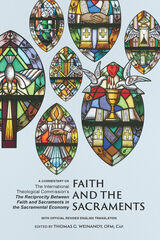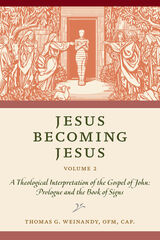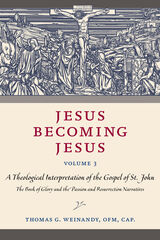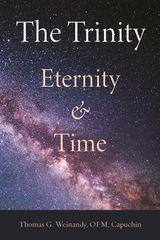5 books by Weinandy, Thomas G.

Faith and the Sacraments
A Commentary on The International Theological Commission's The Reciprocity of Faith and Sacraments in the Sacramental Economy: With Official Revised English Translation
Thomas G. International Theological Comission
Catholic University of America Press, 2022
In September of 2014 thirty new members were appointed for a five-year term to the Vatican’s International Theological Commission. These theologians, clerical and lay, were chosen from twenty-six different countries and from five continents. The commission was charged with composing three documents of contemporary theological importance, one of which was that of the relationship between faith and the sacraments. This finished document was published, with the approval of the Congregation for the Doctrine of the Faith and by Pope Francis in Spanish in early 2020 under the title: La Reciprocidad entre Fe y Sacramentos en la Economía Sacramental. A subsequent English translation was published thereafter under the title The Reciprocity Between Faith and Sacraments in the Sacramental Economy.
This present volume contains the text of the English translation. There follows an introduction by a member of the ITC, Thomas G. Weinandy, OFM, Cap., and subsequently followed by six explanatory and interpretive commentaries on various chapters of the document. Dr. John Yocum considers the contemporary relevance of the topic. Dr. Christopher Ruddy examines the dialogical nature of the sacramental economy of salvation. Dr. Jennifer Holmes Martin discusses the relationship between faith and the sacraments of initiation. There are two commentaries for section four concerning faith and the sacrament of marriage. Professor John Grabowski treats the strictly theological issues relating to faith and marriage. Canonist Timothy Cavanaugh takes up the canonical issues regarding faith and its relationship to enacting a valid sacramental marriage. Dr. Daniel Keating rounds off the commentaries by surveying the conclusion of the document, that is, the present need for evangelization so as to enliven the faith of the faithful, and the present relevance of the new ecclesial movements within the Church today.
These commentaries are aimed at aiding priests and seminarians as they address or prepare to address the pastoral and theological concerns they encounter or will encounter on a daily basis. This volume could also be used in parish adult education groups as well, wherein the laity could better understand the relationship between faith and the sacraments.
[more]

Jesus Becoming Jesus, Volume 2
A Theological Interpretation of the Gospel of John: Prologue and the Book of Signs
Thomas G. Weinandy
Catholic University of America Press, 2021
Jesus Becoming Jesus, Volume 2: A Theological Interpretation of the Gospel of John: Prologue and the Book of Signs follows upon the first volume of this series entitled Jesus Becoming Jesus. The first volume was a theological interpretation of the Gospels of Matthew, Mark and Luke. Unlike many conventional biblical commentaries, Weinandy concentrates on the theological content contained within John’s Gospel. He does this in the light of the Church’s doctrinal and theological tradition, particularly in keeping with the Second Vatican Council’s Dogmatic Constitution, Dei Verbum. This is accomplished through a close reading of John’s Gospel, theologically interpreting each chapter of the Gospel sequentially. In so doing he also takes into account the Johannine corpus as a whole. He also relates John’s Gospel to relevant material found within the Synoptic Gospels, the Pauline Corpus and other New Testament writings.
This original theological interpretation focuses primarily on the intertwining theological themes contained within John’s Gospel, specifically within the Prologue and the Book of Signs – light and darkness, the seven miracle-signs, the sacraments of baptism and the Eucharist, the seven “I Am” sayings, the contentious dialogues with the Jews, Jesus’ relationship to his Father as the Father’s incarnate Word and Son, etc. Within all of these interlocking themes one finds the importance of Jesus’ saving actions – the salvific works of his Father. The overarching theme of this book, as the title suggests, is that Jesus, being named Jesus, throughout his public ministry is enacting his name and so becoming who he is – YHWH-Saves.
Weinandy offers a singular, vibrant, and luminous reading of John’s Gospel; one that reveals the Evangelist’s theological depth and doctrinal sophistication. In so doing, Weinandy makes manifest the particular beauty of the Gospel According to John.
[more]

Jesus Becoming Jesus, Volume 3
A Theological Interpretation of the Gospel of John: The Book of Glory and the Passion and Resurrection
Thomas G. Weinandy
Catholic University of America Press, 2022
Jesus Becoming Jesus, Volume 3 follows upon the previous two volumes of this series entitled Jesus Becoming Jesus. Volume 1 was a theological interpretation of the Gospels of Matthew, Mark and Luke, and volume 2 was a theological interpretation of the Prologue and Book of Signs of John’s Gospel (chapters 1-12). Unlike many conventional biblical commentaries, Weinandy concentrates on the theological content contained within John’s Gospel. This is accomplished through a close reading of John’s Gospel, theologically interpreting each chapter of the Gospel sequentially. In so doing he also takes into account the Johannine corpus as a whole. He also relates John’s Gospel to relevant material found within the Synoptic Gospels, the Pauline Corpus and other New Testament writings.
In this present volume, Weinandy’s original theological interpretation focuses first on the Evangelist’s narrative of the Last Supper, which includes Jesus’ washing of his disciples’ feet, followed upon his lengthy farewell address and his ensuing High Priestly Prayer (chapter 13-17). Although Jesus speaks of his leaving his disciples, yet their hearts should not be troubled, for he is going to prepare a place for them in his Father’s house, and he will also send them another Counselor, the Holy Spirit. The Holy Spirit will not only convict the world sin, but he will also empower the disciples to profess their faith in Jesus as the Father’s Son, even in the midst of persecution. All that Jesus tells his disciple in his final discourse, he then prays that his Father will accomplish through his forthcoming death and resurrection – above all that his disciples will share in the same oneness of love that he and his Father possess.
Weinandy masterfully treats John’s Passion and Resurrection Narratives. He not only theologically interprets the uniqueness of the Evangelist’s narratives, but also how his narratives insect with the Synoptic accounts. Moreover, Weinandy’s theological reading of Jesus’ crucifixion and resurrection weaves together John’s soteriology, ecclesiology, and sacramentality – all of which are founded upon the Incarnation, that Jesus is the Father’s Spirit-filled incarnate Son. As the title suggests, Jesus, being named Jesus, in his death and resurrection, definitively enacts his name and so becoming who he is – YHWH-Saves.
[more]

The Trinity
Eternity and Time
Thomas G. Weinandy
Sapientia Press of Ave Maria University, 2022
In this book, Thomas G. Weinandy, OFM, Cap., examines the Trinity's eternity in relationship to creation's time, particularly in relation to human persons. Because the persons of the Trinity are subsistent-relations-fully-in-act as the one God, they are immutable as to who they are in relationship to one another. Thus they exist in a timeless manner. Moreover, this volume assesses how the eternal Trinity is personally related to human persons over the course of time, and how human persons are personally related to the persons of the eternal Trinity.
In the first part of the book Weinandy treats, in an original and innovative manner, an issue that has been addressed throughout the history of theology, while the second part addresses a related topic that rarely, if ever, has been considered: How does the relationship between the persons of the Trinity and humans change through the saving works of the Trinity - the Incarnation, cross, and Resurrection - and the outpouring of the Holy Spirit? Through faith in the incarnated Son of God, and by participating in the sacraments of baptism and the Eucharist, human persons abide in the risen Jesus. The relationship between eternity and time, in the light of salvation, now takes on a whole new perspective, both epistemologically and ontologically. What will be the relationship between the eternal persons of the Trinity and glorified human beings at the end of time? Time will assume a new heavenly and everlasting dimension. But what will this heavenly novelty be like? The Trinity: Eternity and Time answers these questions and more in a thoroughly philosophical, biblical, and theological manner.
[more]

The Unity of Faith
Essays for the Building Up of the Body of Christ
Thomas G. Weinandy
Catholic University of America Press, 2024
In this volume, The Unity of Faith: Essays for the Building Up of the Body of Christ, Thomas G. Weinandy, OFM, Cap., has compiled a theologically significant medley of essays. The title is taken from Ephesians 4:11–13 (“And his gifts were … for building up the body of Christ, until we all attain to the unity of the faith and of the knowledge of the Son of God….”). The “unity of faith” in this book refers both to the interrelation between the truths of the faith, whether
Trinitarian, Christological, or ecclesiological, and to unity among those who hold the faith.
The first section deals with the Trinity, usually with ecumenical questions in mind, ranging from the question of the filioque to the trinitarian thought of Johnathan Edwards. The second section
presents the author’s mature judgments in a topic for which Weinandy has become notable—the impassability of God and the human suffering of Christ. The third looks at other aspects of Christology with the help of patristic writers, but for sake of the contemporary theological milieu. For example, what is the relationship between the Incarnation and soteriology? What is the nature of Christ’s human consciousness and knowledge? How does Paul perceive the primacy of Christ within his Christological hymns?
The fourth section turns to the unity between faith and reason. In doing Catholic theology, how do theologians apply reason when contemplating the mysteries of faith? What is the philosophical and theological significance of Pope John Paul II’s encyclical, Fides et Ratio? The final section turns to the life of believers in the unity of faith, with topics such as Henri de Lubac’s contributions to ecclesiology, the sacramentality of the Catholic priesthood, the very
delicate issue of the need for conversion and the Jews in relationship to the Church, and the Christian family as a domestic church, taking up the roles of priest, prophet, and king. Weinandy invariably writes in a clear and engaging manner, so much so that these essays will
bring to the greater knowledge of God not only academics and students of theology, but also the educated laity.
[more]
READERS
Browse our collection.
PUBLISHERS
See BiblioVault's publisher services.
STUDENT SERVICES
Files for college accessibility offices.
UChicago Accessibility Resources
home | accessibility | search | about | contact us
BiblioVault ® 2001 - 2024
The University of Chicago Press









